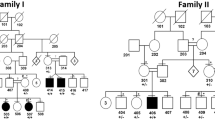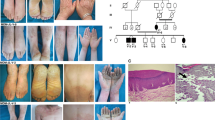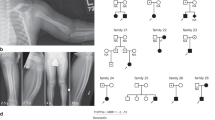Abstract
Pachyonychia congenita (PC) is a rare autosomal dominant condition characterized by multiple ectodermal abnormalities1–3. Patients with Jadassohn-Lewandowsky Syndrome (MIM ♯167200; PC-1) have nail defects (onchyogryposis), palmoplantar hyperkeratosis, follicular hyperkeratosis and oral leukokeratosis4. Those with the rarer Jackson-Lawler Syndrome (MIM ♯167210; PC-2) lack oral involvement but have natal teeth and cutaneous cysts5. Ultra-structural studies have identified abnormal keratin tonofilaments6 and linkage to the keratin gene cluster on chromosome 17 has been found in PC families7. Keratins are the major structural proteins of the epidermis and associated appendages and the nail, hair follicle, palm, sole and tongue are the main sites of constitutive K6, K16 and K17 expression8–10. Furthermore, mutations in K16 and K17 have recently been identified in some PC patients11. Although we did not detect K16 or K17 mutations in PC families from Slovenia, we have found a heterozygous deletion in a K6 isoform (K6a) in the affected members of one family. This 3 bp deletion (AAC) in exon 1 of K6a removes a highly conserved asparagine residue (ΔN170) from position 8 of the 1A helical domain (ΔN8). This is the first K6a mutation to be described and this heterozygous K6a deletion is sufficient to explain the pathology observed in this PC-1 family.
This is a preview of subscription content, access via your institution
Access options
Subscribe to this journal
Receive 12 print issues and online access
$209.00 per year
only $17.42 per issue
Buy this article
- Purchase on Springer Link
- Instant access to full article PDF
Prices may be subject to local taxes which are calculated during checkout
Similar content being viewed by others
References
Kansky, A., Penko, M. & Milakic-Snoj, Z. Pachyonychia congenita. Acta Dermatovener. APA 3, 153–160 (1994).
Feinstein, A., Friedman, J. & Schewach-Millet, M. Pachyonychia congenita. J. Am. Acad. Dermatol. 19 (4), 705–711 (1988).
McKusick, V.A. Mendelian Inheritance in Man, 11th Edition. 1086 (The John Hopkins University Press, Baltimore, 1994).
Thormann, J. & Kobayasi, T. Pachyonychia congenita Jadassohn-Lewandowsky: A disorder of keratinization. Acta Dermat. 57, 63–67 (1977).
Clementi, M., Cardin de Stephani, E., Dei-Rossi, C. & Tenconi, R. Pachyonychia congenita Jackson-Lawler type: a distinct malformation syndrome. Brit. J. Dermatol. 114, 367–370 (1986).
Thomas, D.R. et al. Pachyonychia congenita — Electron microscopic and epidermal glycoprotein assessment before and during isotretinoin treatment. Arch. Dermatol. 120, 1475–1479 (1984).
Munro, C.S. et al. A gene for pachyonychia congenita is closely linked to the keratin gene cluster on 17q12–q21. J. med. Genet. 31, 675–678 (1994).
Bowden, P.E., Stark, H.-J., Breitkreutz, D. & Fusenig, N.E. Expression and modification of keratins during terminal differentiation of mammalian epidermis. in Current Topics in Developmental Biology: The Molecular and Developmental Biology of Keratins. 35–68 (Academic Press, Orlando, 1987).
Stark, H.-J. et al. Keratins of the human hair follicle. “Hyperproliferative” keratins consistently expressed in outer root sheath cells in vivo and in vitro. Differentiation. 35, 236–248 (1987).
Lindberg, K. & Rheinwald, J.G. Three distinct keratinocyte subtypes identified in human oral epithelium by their patterns of keratin expression in culture and in xenografts. Differentiation 45, 230–241 (1990).
McLean, W.H. et al. Keratin 16 and keratin 17 mutations cause pachyonychia congenita. Nature Genet. 9, 273–278 (1995).
Rothnagel, J.A. & Roop, D.R. Molecular genetics of keratin disorders: Analysis and diagnosis. Curr. Opin. Dermatol. 2, 211–216 (1994).
Bonifas, J.M., Rothman, A.L. & Epstein, E.H. Epidermolysis bullosa simplex: evidence in two families for keratin gene abnormalities. Science 254, 1202–1205 (1991).
Rothnagel, J.A. et al. Mutations in the rod domains of keratins 1 and 10 in epidermolytic hyperkeratosis. Science. 257, 1128–1130 (1992).
Rothnagel, J.A. et al. Mutations in the rod domain of keratin 2e in patients with ichthyosis bullosa of Siemens. Nature Genet. 7, 485–9 (1994).
Reis, A. et al. Keratin 9 gene mutations in epidermolytic palmoplantar keratoderma (EPPK). Nature Genet. 6, 174–179 (1994).
Haber, R.M. & Rose, T.H. Autosomal recessive Pachyonychia congenita. Arch. Dermatol. 122, 919–923 (1986).
Franzot, J., Kansky, A. & Kavcic, S. Pachyonychia congenita (Jadasson-Lewandowsky syndrome). A review of 14 cases in Slovenia. Dermatologica 162, 462–472 (1981).
Kansky, A. & Basta-Juzbasic, A. Pachyonychia congenita (Jadasson-Lewandowsky syndrome). Evaluation of symptoms in 36 patients. Arch. Dermatol. Res. 285, 36–37 (1993).
Bowden, P.E. Keratins and other epidermal proteins. in Molecular Aspects of Dermatology.(ed. Priestly, G.C.) 19–54 (John Wiley & Sons, New York, 1993).
Steinert, P.M. & Roop, D.R. Molecular and cellular biology of intermediate filaments. A. Rev. Biochem. 57, 593–625 (1988).
Moll, R., Franke, W.W., Schiller, D.L., Geiger, B. & Krepler, R. The catalog of human cytokeratins: patterns of expression in normal epithelia, tumours, and cultured cells. Cell 31, 11–24 (1982).
Bowden, P.E., Wood, E.J. & Cunliffe, W.J. Comparison of prekeratin and keratin polypeptides in normal and psoriatic human epidermis. Biochem. Biophys. Acta. 743, 172–179 (1983).
Yoon, S.-J., LeBlanc-Straceski, J., Ward, D., Krauter, K. & Kucherlapati, R. Organization of the human keratin type II gene cluster at 12q13. Genomics 24, 502–508 (1994).
Rosenberg, M., RayChaudhury, A., Shows, T.B., LeBeau, M.M. & Fuchs, E. A group of type I keratin genes on human chromosome 17: characterization and expression Molec. cell. Biol. 8, 722–736 (1988).
Chen, M.A., Bonifas, J.M., Matsumura, K., Blumenfeld, A & Epstein, E.H. A novel three-nucleotide deletion in the helix 2B region of keratin 14 in epidermolysis bullosa simplex: ΔE375. Hum. molec. Genet. 2, 1971–1972 (1993).
Tyner, A.L., Eichman, M.J. & Fuchs, E. The sequence of a type II keratin gene expressed in human skin: Conservation of structure among all intermediate filament genes. Proc. Natl. Acad. Sci. U.S.A. 82, 4683–4687 (1985).
Hanukoglu, I. & Fuchs, E. The cDNA sequence of a type II cytoskeletal keratin reveals constant and variable structural domains amongst keratins. Cell 33, 915–924 (1983).
Author information
Authors and Affiliations
Rights and permissions
About this article
Cite this article
Bowden, P., Haley, J., Kansky, A. et al. Mutation of a type II keratin gene (K6a) in pachyonychia congenita. Nat Genet 10, 363–365 (1995). https://doi.org/10.1038/ng0795-363
Received:
Accepted:
Issue Date:
DOI: https://doi.org/10.1038/ng0795-363
This article is cited by
-
Estrogen Action in the Epithelial Cells of the Mouse Vagina Regulates Neutrophil Infiltration and Vaginal Tissue Integrity
Scientific Reports (2018)
-
Mutation p.Leu128Pro in the 1A domain of K16 causes pachyonychia congenita with focal palmoplantar keratoderma in a Chinese family
European Journal of Pediatrics (2014)
-
Epidermal growth factor-induced modulation of cytokeratin expression levels influences the morphological phenotype of head and neck squamous cell carcinoma cells
Cell and Tissue Research (2013)
-
A Large Mutational Study in Pachyonychia Congenita
Journal of Investigative Dermatology (2011)
-
Statins Downregulate K6a Promoter Activity: A Possible Therapeutic Avenue for Pachyonychia Congenita
Journal of Investigative Dermatology (2011)



